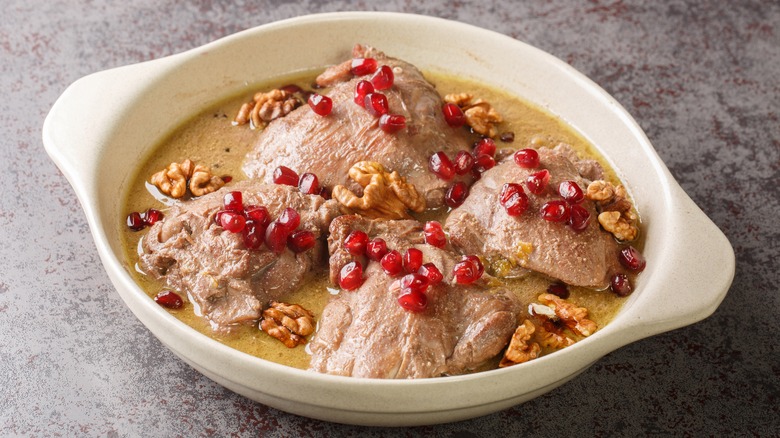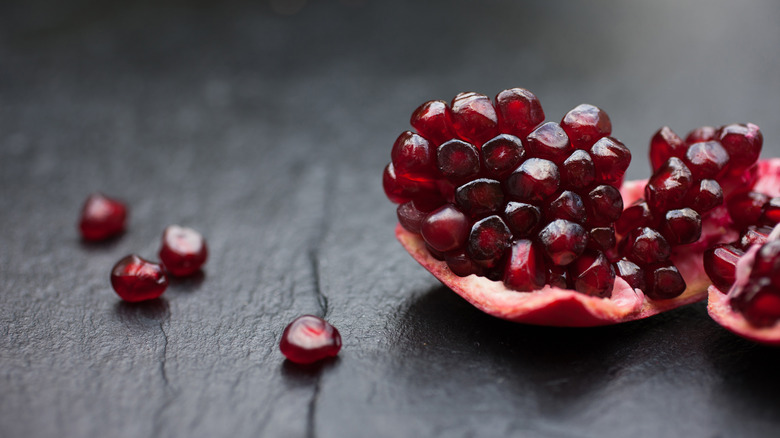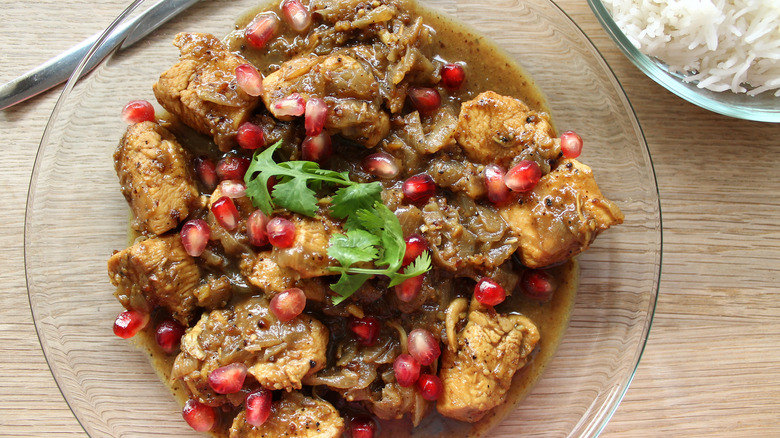The Fruity Ingredient That Makes Iran's Fesenjan Unique
There are certain Persian dishes that have slowly come to define Iranian culture. Around the globe, everyone has their own idea of what Iranian cuisine entails. From chelo kabab koobideh to gondi to Shirazi salad, with basmati rice always at their sides, a quintessential Persian meal is ready to commence. As a cuisine that delicately balances sweet, sour, savory, and spicy flavors, sampling some Persian favorites may be one of the best favors you could do for your palate.
Stews are one of the most commonly made foods across Iran, often featuring many native ingredients. However, of all the warming stews made across the country, fesenjan might be the one most worth getting to know. This celebratory dish is a staple at weddings and certain holidays in the country. A juicy duck in a silky broth is the main attraction in this stew, but the tangy pomegranate seeds and crushed walnuts add another dimension to this famous dish. But even if you're a soup fiend, it takes a trained hand to get this meal just right.
History of fesenjan
It's believed fesenjan first originated in the northern province of Gilan in Iran, a culturally significant province known for its lush beauty, filled with rice fields, tea farms, and sprawling green forests. The province also sits at the base of the Caspian Sea, which creates a climate ideal for growing one of the nation's favorite fruits: pomegranates. Iran is one of the top producers of pomegranates internationally, and while the Gilan province isn't the number one grower in the country, pomegranate trees are still abundant here. Pomegranate is used in several popular dishes in the nation, especially in Northern Iran, but fesenjan is likely the most famous.
Fesenjan is typically eaten during the autumn months, often during Rosh Hashanah celebrations, because the pomegranates are ripe this time of year. Gilan is also known for its abundant wild duck population, which is why it's the meat most commonly featured in this dish today. Other important native ingredients are also showcased in this succulent dish.
Ingredient in fesenjan
Duck is traditionally the preferred meat for this dish, but chicken, lamb, fish and vegetarian substitutions have also become common options. If using poultry, skin-on, bone-in thigh meat works best at producing the most flavorful results.
The broth typically starts with a simple stock or water blended with a ground walnut reduction and, in either case pomegranate molasses. Walnuts (which are often used as a garnish as well) are an ingredient that Iran is a top producer of, and they are integral to this dish, as their nutty, earthy flavor is a great complement to the duck. The dish always includes onions, which can either be cooked in the broth or carmelized and later incorporated into the stew. Salt, pepper, sugar, and, if you like, a medley of regional spices (nutmeg, cinnamon, turmeric, saffron) are seasonings that are commonly sprinkled in fesenjan.
Pomegranate molasses is the unique ingredient that adds dimension to the stew, bringing it a slightly bitter yet sweet flavor. Of course, the country's famous pomegranate seeds or arils are sprinkled on top as well. Just know that if you're planning on making this delicious dish, you'll want to set aside enough time to do so.
How fesenjan is made
You should intend to spend about 2 hours of your day making fesenjan, but we assure you, the rich results are well worth it.
The first step, after securing and measuring out all your ingredients, is to brown your meat skin-side down in an oiled pan. Once your chicken or duck's flesh has turned crisp and golden on both sides, you can add water to the pot to simmer the meat. Separately, some onions should be sautéed. Ground, toasted walnuts can be added to the onion pan once the veggies have been adequately cooked. The onion and walnuts then get added into the pan with the tender meat, along with some seasonings and stock. Pomegranate molasses should also be poured in at this point, and the stew will be left to simmer for about an hour. Once the meat is falling off the bone and the broth is thick and silky, the stew is ready to serve.
Make sure to spoon a large portion over freshly-made basmati rice and sprinkle pomegranate seeds on top. For additional color, you can also add a few sprigs of your favorite complementary herbs. We promise this sweet, earthy, and savory meal will quickly become a celebratory staple in your house.



